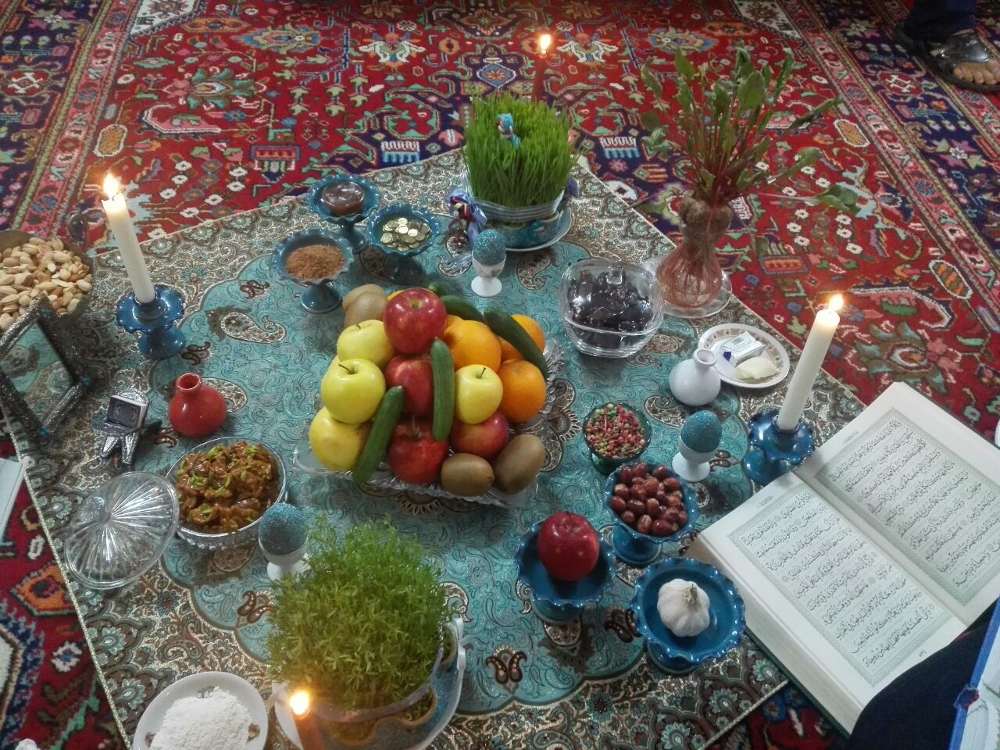Nowruz mobarak!

Frohes Neues!
Heute ist persisches Neujahr (nowruz = neuer Tag), der 1. Farwardin 1395.
Jahreswechsel war morgens um 8 Uhr (5:30 Uhr bei uns). Da der Zeitpunkt nach dem (vorislamischen, zoaroastrischen) Sonnenkalender astronomisch bestimmt wird, liegt er jedes Jahr anders – als wäre bei uns Silvester mal morgens, mal abends oder mal mittags.
Ehsan, Salamzimbo-Mastermind in Shiraz, war heute Morgen am beliebten Mausoleum des Nationaldichters Hafez, wo sich Hunderte versammelt hatten:
Danach ging’s für Ehsan mit Gebäck zum Neujahrsbesuch ins Altenheim. Jetzt erklärt er Euch die „haft seen“:
A major tradition of Nowruz (also Norouz) is the setting of the „haft seen“ (هفت سین) – the seven items starting with letter S or „seen“ (س).
Seven specific items on a table. They symbolically correspond to the seven creations and the seven holy immortals protecting them. Their name must be persian and have to start with س. Also they must be edible, have herbaceous roots and can not be synthetic. Every „seen“ is also a symbol of zoroastian angels. Nowadays the „haft seen“ changed and were modified over centuries, but some have kept their symbolism.
Every family attempts to set a „haft seen table“ as beautiful as they can. It is not only because of special spiritual meaning, but also will be noticed by visitors during Norouzi visitations and is a reflection of their good taste.Some common „haft seen“ are the following:
Sabzeh/Sprouts (سبزه) – wheat, barley or lentil sprouts growing in a dish (symbolising rebirth, clean water and angel of second month of the year | 10–12 days before nourooz everone grow sprouts)
Samanu (سمنو) – a sweet pudding made from wheat germ (symbolising affluence and angel of sixth month of the year | 7–15 days before nowruz some people make samanu, others buy it from shops)
Senjed – the dried fruit of the jujube tree (love)
Seer (سیر) – garlic (medicine, symbol of Ahouramazda)
Seeb (سیب) – apple (beauty and health, angel of woman, symbol of pregnancy and care)
Somaq (سماغ) – sumac berries (the colour of the sunrise, angel of eleventh month of year, symbol of rain)
Serkeh (سرکه) – vinegar (age and patience, angel of fifth month of year, symbol of continuity)
Sonbol – hyacinth flower (the coming of spring)
Sekkeh – coins (prosperity and wealth | if one „haft seen“ is missing, it can be replaced by coins)Other items on the table may include:
pastries
candles (enlightenment and happiness)
a mirror
painted eggs (fertility)
a bowl with goldfish (life, and the sign of Pisces which the sun is leaving | this custom came from China around 100 years ago)
rose water
a holy book or a poetry book (almost always either the Shahnama or Hafez)
Hier noch ein paar „Haft Seen“-Tische von Freunden. Die Fotos sind heute eingetrudelt. Dank an Mama Moji, Moji, Maryam, Ehsan, Fatima, Grandma, Raavi, Sahar, Marzieh, Poona und alle anderen! Happy year 1395!